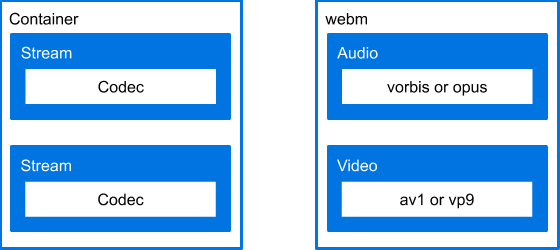In this article you will learn about media file basics such as the concepts of a container, and a few of the many available codec formats that you can use in a stream. Plus lightly touch on topics such as adaptive streaming, bitrate, and resolution—but we'll dive deeper into all these in later sections.
Serving video files
You might think that you can take a raw file from a video camera and just upload it to the web as-is. Indeed, video streaming sites such as YouTube or Vimeo let you do just that, and even provide live-streaming capabilities—typically by connecting to your camera's HDMI port and then processing it through a capture card. These services greatly simplify video processing and uploading, which includes generating the many files and manifests needed for adaptive streaming and various resolutions. Plus the many other complicated and nuanced requirements that make self-hosting a bit of a chore. Preparing and serving a video from your own site, and likely a separate media server, is a bit more complicated than just uploading a raw camera file if you care how your users experience your site.
Video files come in a variety of formats. The format that comes off your camera is
typically a .mov file, or an .mp4 if you have a good modern mirrorless camera.
However, while a .mov is good for recording and for editing and other early
post-production processes, the file size means it's not good for streaming over
the web. As well, the file size of a raw .mp4 in 4K is going to make playing that
file on mobile very prohibitive. Because browsers support different file formats,
you'll need to create multiple optimized files and potentially a manifest if you
plan to support adaptive streaming. Before converting files you need to understand
a few basics about them and about their characteristics.
Containers and codecs, and streams?
The file that you see in your operating system shell is a container,
identified by a file extension (.mp4, .webm, .ogg etc.). The container
houses one or more streams. A media file can have any number of streams, of
many more formats than we'll go into here.
The sample files used later in this section contain at most two streams: an audio stream and a video stream. Among the other types you might encounter are captions and data, both of which are beyond the scope of this article. There are instances where audio and video streams are dealt with separately. Most files you'll encounter will only contain a single audio stream and a single video stream.
Within the audio and video streams, the actual data is compressed using a codec. A codec, or coder/decoder, is a compression format for video or audio data. The distinction between a container and a codec is important because files with the same container can have their contents encoded with different codecs.
The image below illustrates this structure. On the left is the basic container structure with two streams. On the right are the specifics of that structure for a single WebM file.

Files in WebM containers can be orders of magnitude smaller than other formats, making them a good choice for mobile sites to stream. Unfortunately, not all browsers support up-to-date containers and codecs. For example, WebM was created specifically for the web as a high-quality and open source option, but its support is not yet universal. Safari in particular does not, according to Can I use at the time of this writing, support WebM for embedded video. However, WebM does have partial support with the VP8 and VP9 codec used in WebRTC. So your best option is to provide a fallback video.
Codec formats
Many file types support multiple codecs within the same container. A complete list of available video codecs and audio codecs would be a whole website to itself. The links just provided are for MDN's practical lists of what's usable on the web. Listed below are the currently preferred file types, and the codecs they might use. Follow the file type links to view the browsers that support them.
* Indicates the preferred video codec.
Bitrate and resolution
Bitrate is the maximum number of bits used to encode one second of a stream. The more bits used to encode a second of stream, the higher the potential detail and fidelity. We provide more information about this concept in Bitrate.
Resolution is the amount of information in a single frame of video, given as the number of logical pixels in each dimension. We provide more information about this concept in Resolution.
Up next, in Media application basics, we'll show you how to examine these characteristics using two command line tools: Shaka Packager and FFmpeg.


